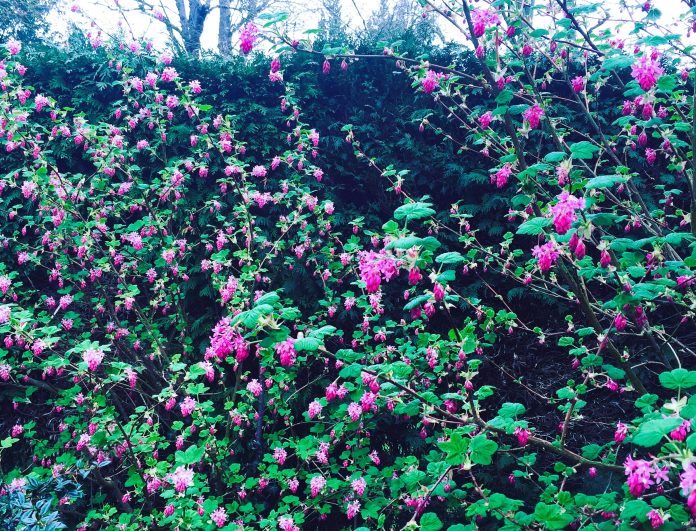Plant Grow Guide:
Taxonomy
- Scientific Name: Ribes sanguineum
- Family: Grossulariaceae
- Common Names: Flowering Currant, Red-flowering Currant
Origin
- Native Range: Western North America, from British Columbia to California.
Plant Type
- Type: Deciduous shrub
Position
- Light: Full sun to partial shade
- Exposure: Sheltered or exposed
Soil
- Type: Well-drained, loamy, sandy, or clay soils
- pH: Neutral to slightly acidic
- Moisture: Moist but well-drained
Size
- Height: 1.8 to 2.5 meters (6-8 feet)
- Spread: 1.5 to 2.5 meters (5-8 feet)
Hardiness
- RHS Hardiness Rating: H6 (Hardy to -20 to -15°C)
- USDA Zone: 5-8
When and How to Plant
- When to Plant: Autumn or early spring.
- How to Plant:
- Choose a well-drained spot with adequate sunlight.
- Dig a hole twice as wide and as deep as the root ball.
- Place the plant at the same depth as it was in its container.
- Backfill with soil, firm gently, and water thoroughly.
- Mulch around the base to retain moisture and suppress weeds.
Flowering
- When it Flowers: Early to mid-spring (March to April in the UK).
- Description: Clusters of pendulous, tubular pink to red flowers, often lightly fragrant.
How and When to Prune
- When to Prune: Immediately after flowering (late spring).
- How to Prune:
- Remove any dead, damaged, or diseased wood.
- Thin out congested growth to improve air circulation.
- Cut back up to one-third of the oldest stems to encourage new growth.
How to Propagate
- Softwood Cuttings (Spring):
- Take 10-15 cm (4-6 inch) cuttings from new growth.
- Remove lower leaves and insert into a mix of sand and compost.
- Keep moist and place in a shaded spot until roots form.
- Hardwood Cuttings (Autumn to Winter):
- Take 20-30 cm (8-12 inch) cuttings from mature stems.
- Insert into well-drained soil outdoors or in a cold frame.
- Leave in place to root over winter.
- Seeds: Sow in autumn for natural stratification or stratify seeds in the refrigerator for 2-3 months before planting.
Pests and Diseases
- Pests:
- Aphids: May cause distorted growth; treat with a strong water spray or insecticidal soap.
- Scale insects: Inspect stems for small, brown bumps and treat with horticultural oil.
- Diseases:
- Powdery Mildew: Avoid overcrowding and ensure good air circulation; treat with fungicide if needed.
- Leaf Spot: Remove affected leaves and avoid overhead watering.
Companion Plants
- Plants it Goes Well With:
- Spring-flowering bulbs like daffodils (Narcissus) or crocuses (Crocus spp.).
- Other early-flowering shrubs like forsythia (Forsythia x intermedia).
- Evergreen shrubs to provide year-round interest, such as holly (Ilex) or boxwood (Buxus).
- Perennials like hellebores (Helleborus) or lungwort (Pulmonaria).
History and Interesting Facts
History in the UK
Ribes sanguineum, commonly known as the flowering currant, was introduced to the UK in 1826 by the renowned Scottish botanist David Douglas. He discovered the shrub during his explorations in Western North America and brought it back to Britain, where it quickly gained popularity. Its hardy nature and early spring blooms made it a favorite in Victorian gardens, particularly in public parks and cottage gardens. The flowering currant’s ability to thrive in urban and rural settings alike solidified its status as a reliable and decorative shrub in British horticulture.
Interesting Facts
- Ribes sanguineum belongs to the gooseberry family and is closely related to other currants and gooseberries.
- Its vibrant flowers are an essential early nectar source for pollinators such as bees, making it a valuable addition to wildlife-friendly gardens.
- Indigenous peoples of North America utilized parts of the plant for medicinal purposes, though its exact applications varied by region.
- While the berries of Ribes sanguineum are technically edible, they are often described as bland or slightly unpleasant in taste.
- During the Victorian era, flowering currants were widely planted in public parks and estates, where their showy springtime display became a symbol of the season’s arrival.
- The shrub is known for its resilience, capable of thriving in a variety of soil types and conditions, which adds to its appeal for gardeners.
Additional Care Tips
- Prune immediately after flowering to shape the shrub and encourage new growth.
- Mulch in spring to retain soil moisture and suppress weeds.
- Water during prolonged dry spells, especially in the first year after planting.
This guide ensures that your Ribes sanguineum thrives and adds a burst of color to your garden in early spring!





